Chapters in Development
Examples for Sight-counting and Sight-singing: Level 1
Levi Langolf
Key Takeaways
- Simple meters are meters in which the beat divides into two, and then further subdivides into four. (To review this topic see Simple Meter and Time Signatures.)
- Time signatures in simple meters express two things: how many beats are contained in each measure (the top number), and the beat unit (the bottom number), which refers to the note value that is the beat.
- This chapter covers beat units of the quarter note and eighth note.
- This chapter covers singular beat divisions.
- A pickup note, also known as an anacrusis, is a note that happens before the first measure of a musical work. This chapter includes anacruses.
- This chapter covers the major and minor modes.
- Melodies within this chapter include stepwise motion.
- This chapter includes two-part rhythms and two-part melodies.
This chapter includes a series of gradated rhythms and melodies which can be used for practicing sight-counting and sight-singing. Conducting while performing these exercises is highly recommended as it can help the performer keep a steady tempo. Knowledge of simple meters, note and rest values, clefs, and key signatures is assumed from the beginning of this chapter. All examples are author-composed.
Section 1
The following eight exercises are in simple duple meter. The quarter note is the beat unit for the first four exercises and the eighth note is the beat unit for the second four exercises.
It is recommended that you use a consistent method of rhythmic solmization.
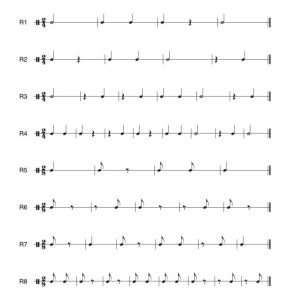
The following two exercises are two-part rhythms that could be performed by counting one line and clapping the other. Which line is counted and which is clapped can and should be interchanged. When clapping a sustained value, try to keep your hands together for the duration of the note and only separate them when clapping again or when performing a rest.
Practice tips:
- Use a metronome
- Slow down the tempo if needed
- Practice counting/clapping one line at a time
- Break the exercise into smaller parts

The following four exercises are in simple duple meter and the major mode. All melodic exercises in this chapter exclusively use stepwise motion in the treble or bass clef, contain no more than four sharps or flats in their key signature, and have an octave or smaller plagal range. For now, exercises will always begin on the first scale degree.
It is recommended that you use a consistent method of solmization.
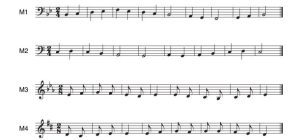
The following four exercises are in simple duple meter and the minor mode. These four exercises are the same melody as M1; however, each uses a different form of the minor scale. Each form of minor contains a unique pattern of accidentals in the upper tetrachord.
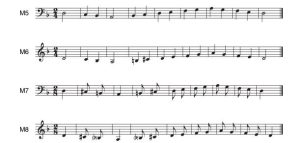
The following two exercises are two-part melodies whose lines could be performed in tandem as a duet or by an individual playing one line on a non-wind instrument and singing the other. Which line is played and which is sung can and should be interchanged. Both exercises are in simple duple meter. The first exercise is in the major mode and the second is in the minor mode.
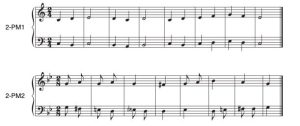
Section 2
The following eight exercises are in simple quadruple meter. Beat divisions are now included.

The following two exercises are two-part rhythms in simple quadruple meter.

The following four exercises are in simple quadruple meter and the major mode. Common time, which is equivalent to ![]() , is now included.
, is now included.
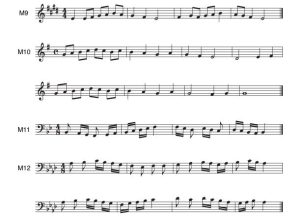
The following four exercises are in simple quadruple meter and the minor mode.
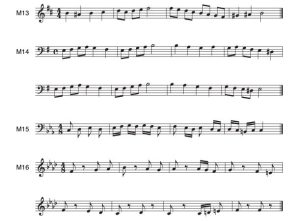
The following two exercises are two-part melodies in simple quadruple meter.
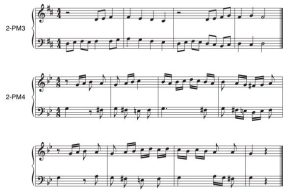
Section 3
The following eight exercises are in simple triple meter. Anacruses and dotted rhythmic values that have the duration of a full measure are now included.
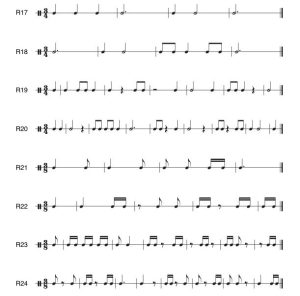
The following two exercises are two-part rhythms in simple triple meter.

The following four exercises are in simple triple meter and the major mode. Melodies can now begin on the third or fifth scale degree of the given key.
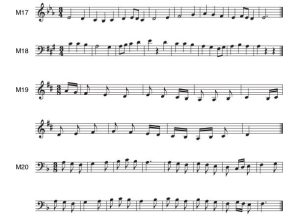
The following four exercises are in simple triple meter and the minor mode.
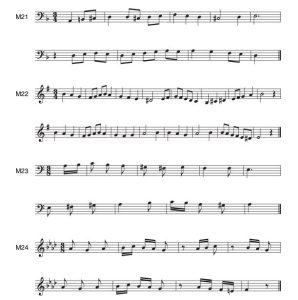
The following two exercises are two-part melodies in simple triple meter.
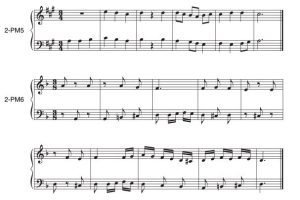
- Melodies for Sight Singing with Recordings (How to Sing Smarter)
- Melodies for Sight Singing (Chorale Tech)
- Melodies for Sight Singing (Ronnie Sanders)
- Rhythms for Sight Counting (Summit Intermediate School Bands)
- Rhythms for Sight Counting (Blue Sky Music)
- Sight Singing by Level (YouTube)
Media Attributions
- Section 1 Rhythms
- Section 1 Two-part Rhythms
- Section 1 Major Melodies
- Section 1 Minor Melodies
- Section 1 Two-part Melodies
- Section 2 Rhythms
- Section 2 Two-Part Rhythms
- Section 2 Major Melodies
- Section 2 Minor Melodies
- Section 2 Two-part Melodies
- Section 3 Rhythms
- Section 3 Two-part Rhythms
- Section 3 Major Melodies
- Section 3 Minor Melodies
- Section 3 Two-part Melodies
A meter that divides the beat into two parts.
An indication of meter in Western music notation, often made up of two numbers stacked vertically.
Which note value gets the beat (e.g., the quarter note in 4/4 or the dotted quarter note in 6/8).
The note value that divides the beat into two or three parts (in simple or compound meters, respectively); for example, the eighth note in 4/4 or 6/8.
Notes on an upbeat that lead into the first downbeat of a phrase.
A meter with two beats, each of which divides into two.
A system that pairs rhythmic values with particular syllables.
A mode with a range of a fifth above and fourth below its tonic.
A single step within a scale; usually indicated by either a solfège syllable or an Arabic numeral with a caret.
A system that pairs each note of a scale with a particular syllable.
A four-note collection.
A meter with four beats, each of which divides into two.
A meter with three beats, each of which divides into two.
